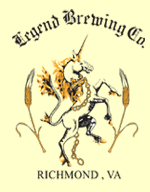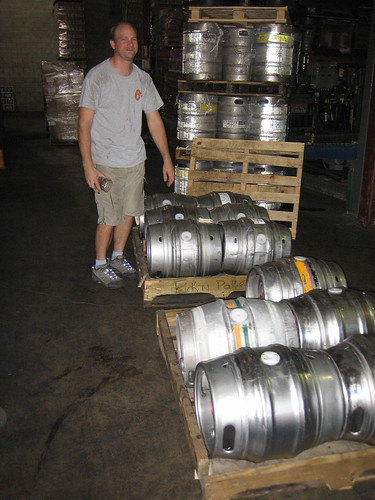On 22 January 1959, Coors Brewing introduced the first-ever twelve-ounce aluminum beer can.
[The aluminum] can ultimately spelled the demise of the tin beverage can developed in the mid-1800s. Industry officials say the development of the Coors aluminum can forever changed the way people drink beer and other beverages.
Hawaii Brewing actually beat Coors to the aluminum can, releasing its Primo in an eleven-ounce can in 1958. From
RustyCan.com:
Unfortunately for Hawaii Brewing, the can was poorly designed and it proved to be a disaster for the brewer. It's one of the first all aluminum beer cans, has a foil label and a soft concave aluminum top. It is also an 11 ounce can, as opposed to the normal 12 ounces most brewers made.
From
breweriana.com:
The Hawaii Brewing Company packaged beer in the first all-aluminum can in 1958. <...> with a paper label.
According to
American Breweries II (Dale Van Wieren, 1995), the Hawaii Brewing Company was in operation from 1934 until 1964.
****************
The first ever beer in cans —tin steel— were released for sale in Richmond, Virginia, by the
Gottfried Krueger Brewery of Newark, New Jersey, on 24 January 1935.
The tin can —in part because of its cheap cost— was never much of a candidate for recycling, whereas the aluminum can was.
"The tin-plated can was probably the worst container that anybody ever developed for beer," Bill Coors told the Rocky [Mountain News] last year. "You had lead solder on the seams. You had the tin plate. Steel base. Steel body of the can."
The Coors family argued that the metal can was bad for beer: It produced a lousy aftertaste. What's more, Bill Coors reasoned, the metal cans were littering America's landscape. They weren't easily recycled. <...>
[The aluminum can] also opened a new market for sheet aluminum and, eventually, for aluminum recycling.
The United States Brewers Association opposed the switch to aluminum, specifically
because of the recycling issue.
the brewers association "was adamantly opposed to any of the brewers - and this included the soft-drink people - taking any responsibility for their empty containers. It wasn't our fault that they were spread all over the ground."
There was also the issue of formaldehyde used in the process of steel-can making, an additive
no longer an issue with today's aluminum cans.
A plastic lining in aluminum cans forestalls any metallic flavor, a flaw which apparently had been evident in those earlier tin cans. But there remain
other health concerns, if lesser, as a by-product of the manufacturing process.
The introduction of aluminum cans apparently was also a spur to the mystique of 'fresh' Coors. To kill beer-spoiling bacteria and to stabilize their beers for long-distance shipping, breweries would (and still do) pasteurize their beers —that is, heat to about 165 °F. But with the introduction of aluminum, Coors felt confident to switch to "cold filtering".
At the time, Bill Coors also was keen to do away with pasteurization - a process he believed affected beer's taste.
"You needed a container that was clean on the inside that could be easily rinsed out and sterilized," Coors told the Rocky Mountain News. "It was impossible with the old can."
Coors celebrates aluminum can's golden milestone
By Roger Fillion
Rocky Mountain News
22 January 2009
The term might be brilliant marketing, but it is a misnomer.
All beer filtration occurs at 'cold' temperatures of about 28 - 34°F. The phrase, as used by Coors, actually refers to sterile filtration, which is filtering beer at microscopic levels to remove bacteria. Such precise filtering also removes flavor, aroma, and color compounds, all of which are larger than bacteria.
So it became a Hobson's choice for mega-breweries: pasteurize —and create stale flavors— or sterile filter out actual flavor compounds.
Many craft breweries are adopting a different route, adding small amounts of live yeast into the bottle. Yeast consumes oxygen (the major agent of staling) and helps deter bacterial growth.
Sierra Nevada Brewing was one of the craft beer pioneers of this process —called bottle-conditioning— here in the US. An ages old technique, it has again become new.
The adoption of canning by craft breweries was an uphill battle. Brooklyn Brewing was an early practitioner, but only in limited amounts and limited brand choices.
The impression was that cans were appropriate only for mainstream, low-flavored beers. "Cans are for baked beans, not fine beverages," a craft beer mover and shaker
huffed in 1997. But cans, large and small, have several advantages versus glass bottles.
Sunlight —
and the fluorescent lights found in most store's beer cases— rapidly reacts with hops in beer to create the flavor for which a certain imported beer in a green bottle is famous: skunkiness, literally the chemical created by a skunk when threatened. Even brown bottles can only protect beer for a few minutes.
Cans, being opaque, never suffer from this odoriferous defect. Cans are less bulky than bottles. They stack easier, and they weigh less. Cans chill faster than bottles. Cans can 'go' where bottles cannot (such as public places, etc.).
The issue should
not be the packaging, but the manner in which the beer is drunk. Drinking a beer out of the bottle is as inelegant and injurious to true flavor and aroma as drinking out of a can. Once beer is poured into a glass, the original container becomes superfluous.
To date,
Oskar Blues of Colorado has been one of the most successful craft breweries to can its beers. Its flagship beer, Dales Pale Ale, named for the brewery's owner and released in cans in 2002, has become almost a totem of the craft canned beer industry. Other craft breweries have followed, although, as of 2009, the percentage remains small. [UPDATE 2013. Since I first posted this story, many 'craft' breweries have embraced cans as their package of choice. I don't have actual numbers, however.]
Still having a problem swallowing the idea of 'good' beer in a can? Keep in mind that a keg is indeed a large stainless steel can!

































